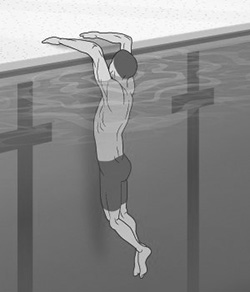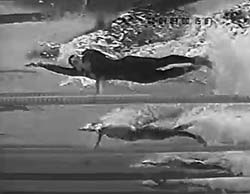The freestyle – front crawl – catch may be the single most misunderstood thing in swimming. Arguably, the catch itself provides no actual propulsion and in many ways, the catch is nothing more than a brief transitional phase between the entry and the pull.
 When the catch is done correctly, you will be more effective through the entire pull phase, resulting in a powerful, fast stroke. Done incorrectly, you will have an inefficient stroke that generates very little forward thrust.
When the catch is done correctly, you will be more effective through the entire pull phase, resulting in a powerful, fast stroke. Done incorrectly, you will have an inefficient stroke that generates very little forward thrust.
The importance of the catch becomes apparent when you consider that the greatest difference between average swimmers (this includes the VAST majority of triathletes) and an elite swimmer is that the elite swimmer has an immensely superior catch.
Another name for the catch is the Early Vertical Forearm – and that’s where the elusiveness comes in. Many think they have established a vertical forearm during the catch, yet in reality they are leading their stroke with their elbow.
By working on your catch and early vertical forearm, you can improve your stroke technique and become more efficient in the water.
Here are some tips to help you the develop the “Early Vertical Forearm” (EVF) and improve your catch.
Reach High
Start in the shallow end of the pool along the side by the deck. You need to be able to easily stand. Face the edge of the pool with your stomach lightly touching the wall. Now put both your arms straight up from your shoulders like you’re trying to reach something above you. This is where you’ll “start your stroke.”
Begin the Catch
Drop low in the water so you’re at eye-level with the edge of the deck. With  your forearm and locked wrist acting as a single unit, bend your elbows and move your forearms toward the deck like you’re starting a catch. It is crucial that you keep your wrist as stiff as possible on your catch to maximize the amount of water that you grip and push past you. At this point, your forearms should be lying flat on the deck with your palms facing down. Your elbows should be as high as your head and at shoulder width if possible – shoulder flexibility may inhibit this movement. If you are able to mimic this position, then you can achieve an Early Vertical Forearm during your catch.
your forearm and locked wrist acting as a single unit, bend your elbows and move your forearms toward the deck like you’re starting a catch. It is crucial that you keep your wrist as stiff as possible on your catch to maximize the amount of water that you grip and push past you. At this point, your forearms should be lying flat on the deck with your palms facing down. Your elbows should be as high as your head and at shoulder width if possible – shoulder flexibility may inhibit this movement. If you are able to mimic this position, then you can achieve an Early Vertical Forearm during your catch.
Tip: To achieve the early vertical forearm you must inwardly rotate your upper arm. If you’re having difficulty establishing this position – raise your arms over your head. Bend one elbow to 90-degrees, laying your forearm on top of your head with your palm facing the floor. Now rotate your bent arm to the position in the picture.
You Need Time to Develop the Catch
It’s difficult for most triathlete’s to initially achieve an early vertical forearm. When you are swimming normal freestyle, things are happening too quickly to properly develop a catch/EVF so you need to slow things down. The best way to do that is to use a catch-up drill to first develop your EVF. When swimming a catch-up drill, pause your leading arm until your recovering hand actually touches your lead hand – catches up. As you start your catch, imagine the wall still pressing against your body. As soon as you begin your pull, bend your elbow while creating a stiff forearm and wrist. Remember your elbow doesn’t begin to move back until you’ve established the EVF. Proper position will have you hand directly under your elbow while your elbow is still above your head. This position, coupled with your body’s counter rotation, allows you to activate the large muscle groups of your back and core creating a strong efficient pull.
Swim Regular Freestyle
As you become more comfortable and your catch begins to feel more  natural, switch to normal freestyle. When swimming freestyle at normal speed, it is quite easy to believe you are achieving a vertical forearm when in reality you are falling just short. Having a friend video tape you from the side above water will quickly reveal if your hand is directly beneath your elbow.
natural, switch to normal freestyle. When swimming freestyle at normal speed, it is quite easy to believe you are achieving a vertical forearm when in reality you are falling just short. Having a friend video tape you from the side above water will quickly reveal if your hand is directly beneath your elbow.
Tip: Freestyle sculling can be quite useful to recreate and practice the early vertical forearm movement. Begin in a streamline position with your hands outstretched in front of you at shoulder width in a neutral position. With one arm, recreate the motion you did while standing at the wall – thus establishing the vertical forearm – then return to the neutral position. Repeat with alternating hands. Using a pull-buoy between you legs will help prevent your legs from dropping.
Keep Working on It
Now that you know what a true catch/EVF is, continue working on your catch technique. Focus on where your hands are in relation to your elbows as that defines your catch technique. With some patience and a small dose of persistence, you’ll be swimming faster while expending less energy. On race day that can only mean good things!
